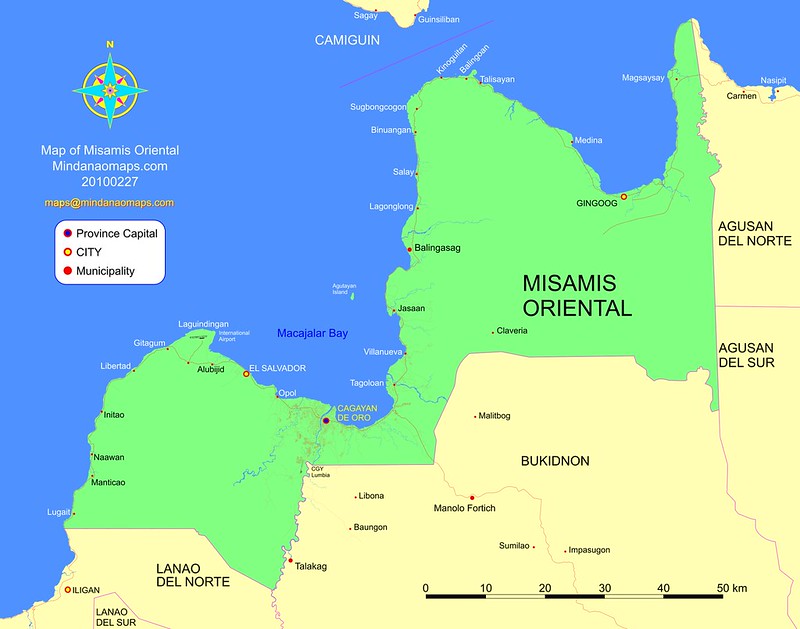Misamis Oriental is a part of Region X and the capital city is Cagayan de Oro. It is also the biggest city in Region X.
Misamis Oriental (Cebuano: Sidlakang Misamis) is a province located in the region of Northern Mindanao in the Philippines. Its capital and provincial center is the city of Cagayan de Oro, which is governed independently from the province. Misamis Oriental is a part of Region X and the capital city is Cagayan de Oro. It is also the biggest city in Region X.
HISTORY:
Around the 10th Century, the area of what is now Misamis Oriental was under the Indianized Kingdom called Rajahnate of Butuan.
In the 16th century, Muslims from Malaysia came and then displaced the non-Muslim Lumads northwards as they came to control most of Mindanao, the inhabitants were converted into Islam. As part of Mindanao, the people of the territory were obliged to pay tribute to Muslim rulers. Misamis Oriental is a part of Region X and the capital city is Cagayan de Oro. It is also the biggest city in Region X.
Province of Cebu:
Misamis Oriental shared a history with Misamis Occidental of being part of the Province of Cebu during the Spanish colonial era. In 1818, Misamis was carved out from Cebu to become a separate province with Cagayan de Misamis (Cagayan de Oro) as its capital, and was further subdivided into partidos or divisions: Partido de Cagayan (Division of Cagayan), Partido de Catarman (Division of Catarman), Partido de Dapitan (Division of Dapitan), and Partido de Misamis (Division of Misamis). The new Misamis province was part of the districts of Mindanao during the later part of the 19th Century, with its territory spanning from Dapitan to the west, Gingoog to the East, and as far as Lanao and Cotabato to the south.
Misamis is one of the Spanish-controlled territories vulnerable to Moro raids. The Fuerza de la Concepcion y del Triunfo in Ozamiz was built as a Spanish military installation and one of the staging points in their expeditions against Moros. A fort in Balo-i in present-day Lanao del Norte was also constructed in 1891 on the orders of General Valeriano Weyler in its renewed campaign against the Maranaos. The Fuerza de San Miguel in Iligan was also built, serving as a muster point for Spanish forces in their campaigns in Lanao.
Misamis Province:
With the organization of the Department of Mindanao and Sulu in 1917, Misamis lost a territory covering Iligan and coastal towns along Iligan and Panguil bays to become part of the Lanao province, making the remaining western and eastern territories of Misamis isolated to each other. Highland areas south of Cagayan de Misamis down to Malaybalay area were carved out to become a sub-province of Bukidnon in 1914, then eventually a full province in 1917.
Legislative Act. No. 3537 approved on 2 November 1929, divided the province of Misamis into two due to the lack of geographic contiguity. It was not until a decade later, on 28 November 1939, that the division between Misamis Oriental and Misamis Occidental was implemented by Act. No. 3777. When Misamis Oriental separated, Don Gregorio Pelaez became its first governor.
World War II:
In 1942, at the onset of World War II in the Philippines, Japanese soldiers landed in Misamis Oriental to occupy the region.
Combined American and Philippine Commonwealth forces along with recognised guerrilla fighters liberated Misamis Oriental in 1945.
Modern History:
Subsequent creations of new local government units occurred after the war. Lagonglong was a barangay of Balingasag when it was chartered to become a separate municipality in 1949, achieving full municipality status in 1959.
The island of Camiguin was part of the province, and in 1958 it was made into a sub-province. The island eventually separated from Misamis Oriental and achieved regular province status in 1966, with Mambajao as its new provincial capital.
In May 2014 it was reported that an area in Barangay Lapad in Laguindingan, Misamis Oriental, in northern Mindanao, was declared a heritage site. Oyster fossils older than 200,000 years were discovered, according to Balita Pilipinas. Property owner, Raul Ilogon, told Balita Pilipinas that they had been seeing the fossils for 20 years thinking that they were ordinary rocks.
SOURCE: wikipedia.org/wiki/Misamis_Oriental
ADMINISTRATIVE DIVISIONS:
Misamis Oriental comprises 23 municipalities and 2 component cities, which are organized into two legislative districts and further subdivided into 424 barangays. The provincial capital, Cagayan de Oro, is a highly urbanized city that is administered independently from the province.
1st DISTRICT:
Balingasag
Balingoan
Binuangan
Gingoog – Component city.
Kinoguitan
Lagonglong
Magsaysay
Medina
Salay
Sugbongcogon
Talisayan
Legislative Districts of Cagayan de Oro – Provincial capital and highly urbanized city. The Legislative Districts of Cagayan de Oro are the representations of the highly urbanized city of Cagayan de Oro in the various national legislatures of the Philippines. The city is currently represented in the lower house of the Congress of the Philippines through its first and second congressional districts.
Source: wikipedia.org/wiki/Legislative_districts_of_Cagayan_de_Oro
2nd DISTRICT:
Alubijid
Claveria
El Salvador – Component city.
Gitagum
Initao
Jasaan
Laguindingan
Libertad
Lugait
Manticao
Naawan
Opol
Tagoloan
Villanueva

